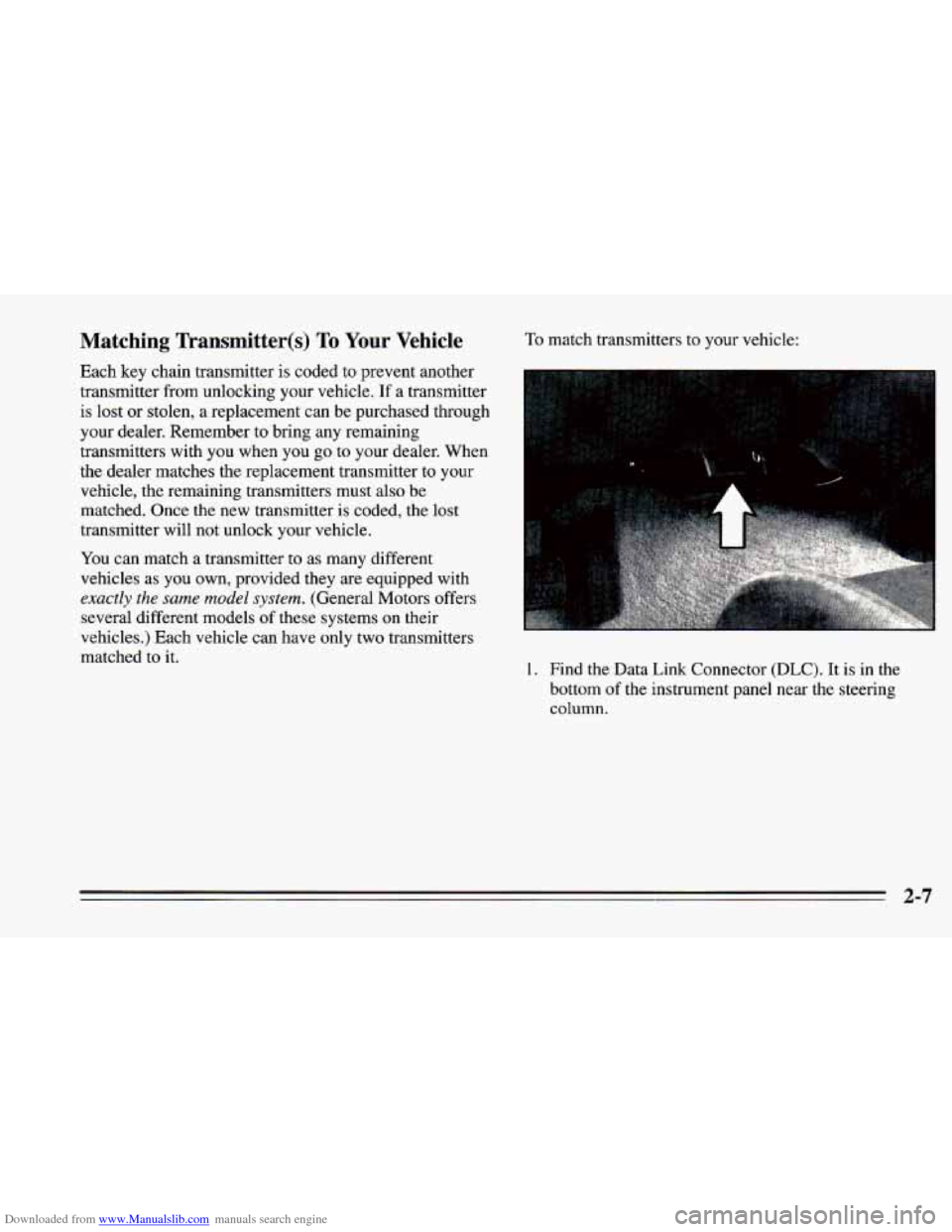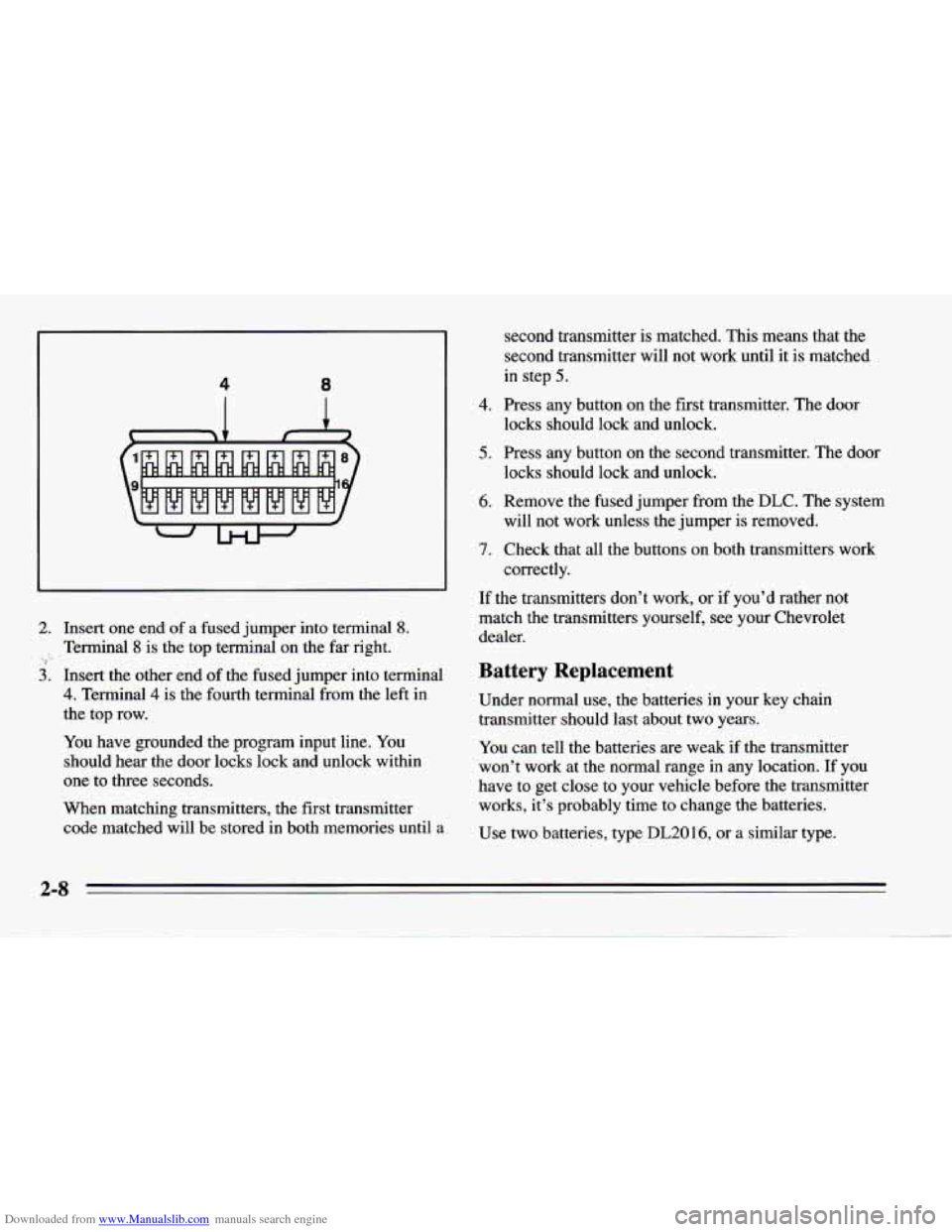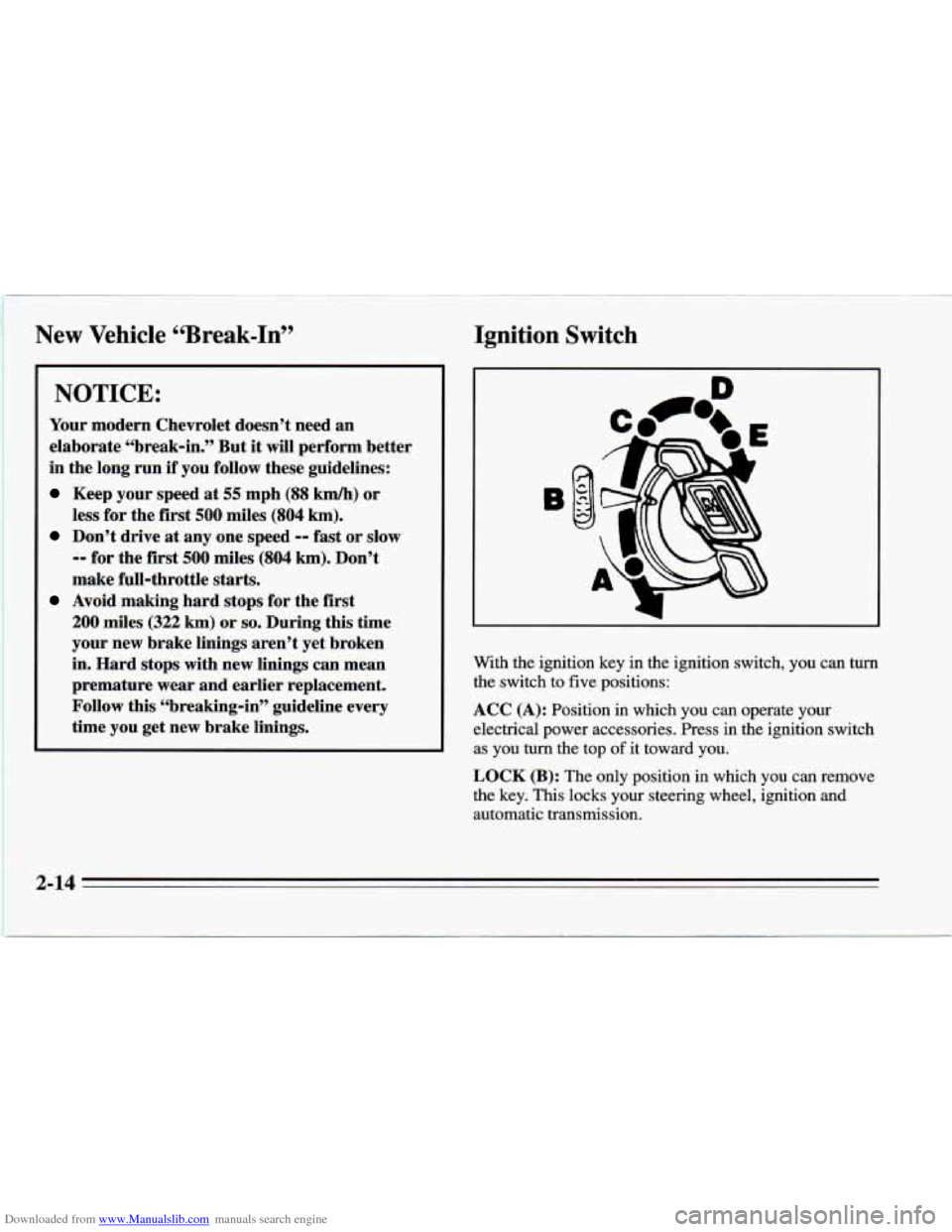Page 59 of 388

Downloaded from www.Manualslib.com manuals search engine Matching Transmitter@) To Your Vehicle
Each key chain transmitter is coded to prevent another
transmitter from unlocking your vehicle. If a transmitter
is lost or stolen, a replacement can be purchased through
your dealer. Remember to bring any remaining
transmitters with you when you
go to your dealer. When
the dealer matches the replacement transmitter to your
vehicle, the remaining transmitters must also be
matched. Once
the new transmitter is coded, the lost
transmitter will not unlock your vehicle.
You can match a transmitter to as many different
vehicles as you own, provided they are equipped with
exactly the same model system. (General Motors offers
several different models
of these systems on their
vehicles.) Each vehicle can have only two transmitters
matched to it.
To match transmitters to your vehicle:
1. Find the Data Link Connector (DLC). It is in the
bottom of
the instrument panel near the steering
column.
Page 60 of 388

Downloaded from www.Manualslib.com manuals search engine 4 8
1
c
c
-w
I
2. Insert one end of a fused jumper into terminal 8.
, Terminal 8 is the top terminal on the far right. ,> ,_ .
3. Insert the other end of the fused jumper into terminal
4. Terminal 4 is the fourth terminal from the left in
the top row.
You have grounded the program input line. You
should hear the door locks lock and unlock within
one to three seconds.
When matching transmitters, the first transmitter
code matched will be stored in both memories until a second
transmitter is matched.
This means that the
second transmitter will not work until it is matched
in step
5.
4. Press any button on the first transmitter. The door
locks should lock and unlock.
5. Press any button on the second transmitter. The door
locks should lock and unlock.
6. Remove the fused jumper from the
DLC. The system
7. Check that all the buttons on both transmitters work
will not work unless the
jumper is removed.
correctly.
If the transmitters don’t work,
or if you’d rather not
match the transmitters yourself, see your Chevrolet
dealer.
Battery Replacement
Under normal use, the batteries in your key chain
transmitter should last about two years.
You can tell the batteries are weak if the transmitter
won’t work at the normal range
in any location. If you
have to get close to your vehicle before the transmitter
works, it’s probably time to change the batteries.
Use two batteries, type
DL20 16, or a similar type.
Page 61 of 388
Downloaded from www.Manualslib.com manuals search engine To replace batteries in the Remote Lock Control:
1. Carefully pry off the cover by inserting a dime (or
2. Lift off the front cover, bottom half first.
similar object)
in a
slot between the covers and twist.
3. Remove and replace the batteries. Put new batteries
in printed side down.
4. Replace the front cover. Make sure the cover is on
tightly
so water won’t get in.
5. Check the transmitter operation.
Hatch Release
Your door key opens the hatch.
2-9
Page 62 of 388
Downloaded from www.Manualslib.com manuals search engine Remote Hatch Release (Option)
I\
‘
Press the switch in your glove box to unlock the hatch
from inside your vehicle.
If you have an automatic
transmission, your shift lever must be in PARK
(P) or
NEUTRAL (N) to use the switch. If you have a manual
transmission and the ignition switch is in
RUN, you
must
set the parking brake before you can use the
switch. The
switch only works when the ignition switch
is in.
RUN or ACC, or when RAP is present. (See “Retained
Accessory
Power” in the Index.)
NOTICE:
If you put things in the hatchback area, be sure
they won’t break the glass when
you close it.
Never slam the hatch down.
You could break the
glass or damage the defogger grid (if equipped).
2-10
Page 63 of 388
Downloaded from www.Manualslib.com manuals search engine I I
I
!
I
Theft
Vehicle theft is big business, especially in some cities.
Although your Chevrolet has a number
of theft deterrent
features,
we know that nothing we put on it can make it
impossible to steal. However, there are ways you can
help.
Key in the Ignition
If you walk away from your vehicle with the keys
inside, it’s an easy target for joy riders or professional
thieves
-- so don’t do it.
When you park your Chevrolet and open the driver’s
door, you’ll hear a tone reminding you to remove your
key from the ignition and take it with you. Always do
this. Your steering wheel will be locked, and
so will
your ignition. If you have an automatic transmission,
taking your key out also locks your transmission. And
remember to lock the doors.
2-11
Page 64 of 388
Downloaded from www.Manualslib.com manuals search engine Parking at Night
Park in a lighted spot, close all windows and lock your
vehicle. Remember to keep your valuables
out of sight.
Put
them in a storage area, or take them with you.
Parking Lots
If you park in a lot where someone will be watching
your vehicle, it’s best to lock it up and take your keys. \
But what if you
have to leave your ignition key? What if
you have to leave something valuable in your vehicle?
Put your valuables in a storage area, like your trunk
or glove box.
0 Lock the glove box.
0 Lock all the doors except the driver’s.
0 Then take the door key with you.
. ‘i
PASS-Key@II
Your vehicle is equipped with the PASS-Key%
(Personalized Automotive Security System)
theft-deterrent system. PASS-Key I1
is a passive
theft-deterrent system. It works when you insert or
remove the key from
the ignition. PASS-Key I1 uses a
resistor pellet
in the ignition key that matches a decoder
in your vehicle.
2-12
Page 65 of 388

Downloaded from www.Manualslib.com manuals search engine When the PASS-Key@II system senses that someone is using the wrong key, it shuts down the vehicle’s starter
and fuel systems. For about three minutes, the starter
won’t work and fuel won’t
go to the engine. If someone
tries to start your vehicle again or uses another key
during this time, the vehicle will not start. This
discourages someone from randomly trying different
keys with different resistor pellets in an attempt to make
a match.
The ignition key must be clean and dry before it’s
inserted in the ignition or the engine may not start. If the
engine does not start and the SECURITY light stays on
when you try to start the vehicle, the key may be dirty or
wet. Turn the ignition
off.
Clean and dry the key. Wait about three minutes and try
again. The security light will remain on during this time.
If the starter still won’t work, and the key appears to be
clean and
dry, wait about three minutes and try another
ignition key.
At this time, you may also want to check
the fuses (see “Fuses and Circuit Breakers” in the
Index).
If the starter won’t work with the other key, your vehicle
needs service.
If your vehicle does start, the first
ignition key may be faulty. See your Chevrolet dealer or
a locksmith who can service the PASS-Key’II.
If you accidentally use
a key that has a damaged or
missing resistor pellet, the starter won’t work and the
security light will flash. But you don’t have to wait three
minutes before trying another ignition key.
See your Chevrolet dealer or a locksmith who can
service the PASS-Key’II to have a new key made.
If you’re ever driving
and the “SECURITY” light comes
on and stays on, you will be able to restart your engine if
you turn it
off. Your PASS-Key@II system, however, is
not working properly and must be serviced by your
Chevrolet dealer. Your vehicle
is not protected by the
PASS-Key@II system.
If you lose or damage a PASS-Key’II ignition key, see
your Chevrolet dealer or a locksmith who can service
PASS-Key’II
to have a new key made. In an
emergency, call the Chevrolet Roadside Assistance
Program at 1-800-CHEV-USA
(1-800-243-8872).
2-13
Page 66 of 388

Downloaded from www.Manualslib.com manuals search engine New Vehicle “Break-In” Ignition Switch
NOTICE:
Your modern Chevrolet doesn’t need an
elaborate “break-in.” But it will perform better
in the long run if you follow these guidelines:
Keep your speed at 55 mph (88 km/h) or
less for the first
500 miles (804 km).
Don’t drive at any one speed -- fast or slow
-- for the first 500 miles (804 km). Don’t
make full-throttle starts.
200 miles (322 km) or so. During this time
your new brake linings aren’t yet broken
in. Hard stops with new linings
can mean
premature wear and earlier replacement.
Follow this “breaking-in’’ guideline every
Avoid making hard stops for the first
I
time you get new brake linings. With
the ignition key in the ignition switch, you can turn
the switch to five positions:
ACC
(A): Position in which you can operate your
electrical power accessories. Press in the ignition switch
as you
turn the top of it toward you.
LOCK (B): The only position in which you can remove
the key. This locks your steering wheel, ignition and
automatic transmission.
2-14